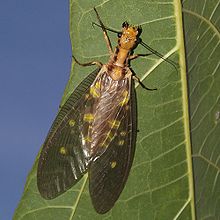Chauliodinae: Difference between revisions
No edit summary |
|||
| Line 24: | Line 24: | ||
==Footnotes== |
==Footnotes== |
||
{{Reflist}} |
{{Reflist}} |
||
it's cool |
|||
==References== |
==References== |
||
Revision as of 03:16, 23 November 2010
| Chauliodinae | |
|---|---|

| |
| Protohermes grandis | |
| Scientific classification | |
| Domain: | Eukaryota |
| Kingdom: | Animalia |
| Phylum: | Arthropoda |
| Class: | Insecta |
| Order: | Megaloptera |
| Family: | Corydalidae |
| Subfamily: | Chauliodinae |
| Genera | |
Fishflies are the members of the subfamily Chauliodinae, belonging to the megalopteran family Corydalidae[1]. They are most easily distinguished from their closest relatives, dobsonflies, by the jaws (mandibles) and antennae. In contrast to the large (especially in males) jaws of dobsonflies, fishfly mandibles are not particularly large, menacing or obvious, and the males have feathery antennae similar to many large moths. Chauliodes pectinicornis, the "summer fishfly", is a well-known species in North America.
In contrast to mayflies, which are small and live only 24 hours as adults, Fishflies are quite large, eat aquatic plants as well as smallish animals including vertebrates like minnows and tadpoles, and may live up to seven days as adults. Their entire lifespan is several years, but most of this time is spent as larvae.
Along the Upper Mississippi River, and its tributaries, on one evening around June, the newly-hatched fishflies rise to the air by the billions. River towns are afflicted with a night's worth of misery and days' worth of cleanup. Depending upon the wind, they can go many miles inward, or within the Driftless Area, a good 660 feet upward and across.
Footnotes
- ^ See references in Haaramo (2008)
it's cool
References
- Haaramo, Mikko (2008): Mikko's Phylogeny Archive: Corydalidae. Version of 2008-MAR-11. Retrieved 2008-MAY-05.
External links
- BugGuide.net
- InsectIdentification.org
- University of Kentucky
- University of Virginia
- InsectIdentification.org Fishfly photos
